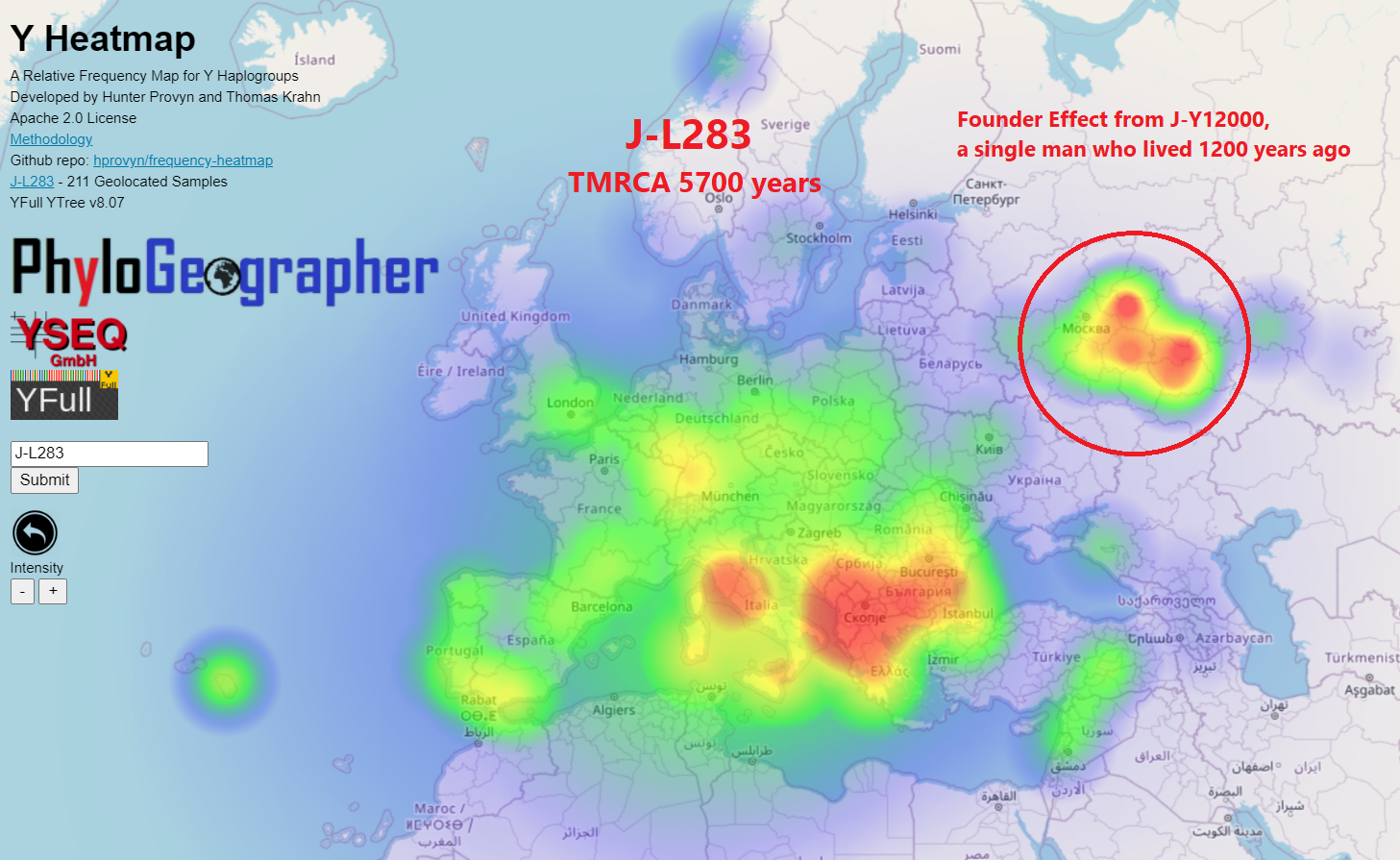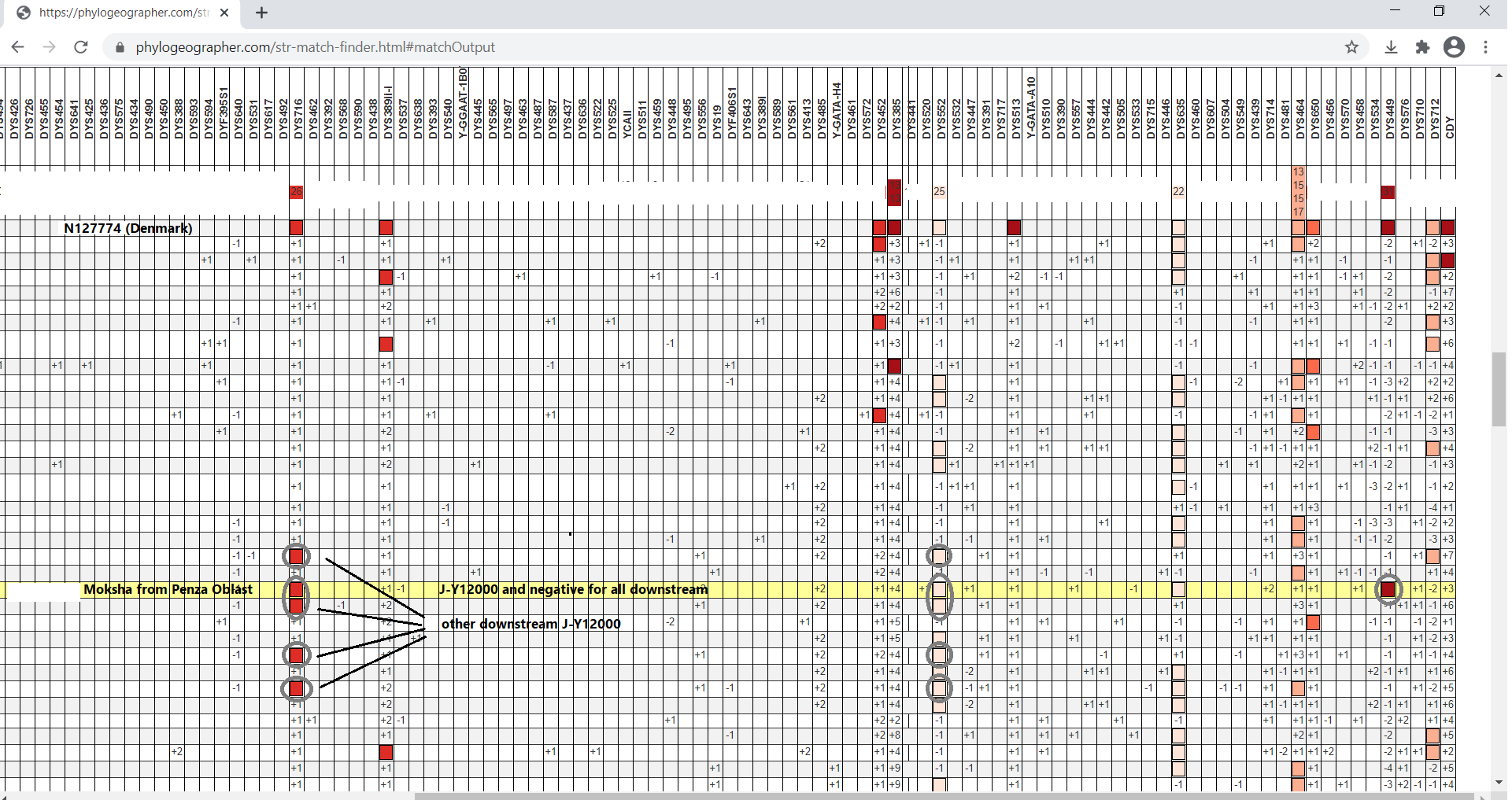A man of Danish descent, N127774, already confirmed J2b-Z1043, I am testing to see whether he may be a distant relative to the Mishar Tatar - Moksha lineage J2b-Z1043>...>Y12000 centered around Mordovia.
These Mishar Tatars and Mokshas are a prolific lineage descending from one man who lived about 1200 years ago (YFull estimate), whose founding effect causes the J2b-L283 hotspot seen on Y Heatmap in Russia.

This lineage is one of the most extreme outliers in J2b-Z631>Z1043 which is assumed to be of Italian or NW Balkan origin and various theories have been proposed to explain their migration to the area around Mordovia.
I summarized a few of the theories here - Aug 2019 article on J2b-Y12000. Main outdated thing in the article is that I no longer think its parent J2b-Y12007 was from Central Europe and a Celt - it has since been found in Tuscany and Bulgaria. I consider the J2b-Y12000 origin question to be the most interesting unresolved question in J2b-Z631, short of the origin of the J2b-Z631 and Z1043 ancestors themselves.
The update I made a few months back to STR Match Finder (Developed by Hunter Provyn in cooperation with YSEQ - Thomas Krahn and Yahya Alalie), showed me that his most stable rare allele, DYS716 = 26, is shared almost exclusively with men of J2b-Y12000. Secondary, less rare allele DYS552 = 25 is also shared by this group. Video tutorial for STR Match Finder.

A third interesting thing, while DYS449 is the fifth most unstable STR of the 111, this man shares a very rare allele 31 with the basal J-Y12000 man, who is a Moksha from Penza Oblast. He is off by one among the other J-Y12000 men, and off by one or more among other men.
The way we predict that a group of men may inherit a STR allele(s) (i.e. a particular number for a given STR) from a common ancestor is by first confirming that the ancestor BEFORE such point likely did not already have this mutation. Then we can be more confident that when multiple people have it AFTER such a common ancestor it means they inherited it from one man who lived later.
So that's why we try to infer what the ancestral allele of a subclade was based on the alleles of men of the different descendant lineages who are living today. "Ancestral allele" means the value of the allele we think the MRCA of a subclade had.
No one else in J-Y12007 has DYS716 = 26 so we know this mutation COULD HAVE BEEN inherited from the men in the J-Y12000 bottleneck because it was not the allele inherited from the J-Y12007 ancestor. However, another man with this rare allele could still have derived it independently by chance. That's why SNP test verification is necessary to confirm any STR based prediction.
DYS552 is not quite as rare and is less stable. I checked some of the J2b-Y12007 men and they have 24 instead of 25, but 25 is found in several lineages of J2b-Z8429 so it's not a clear signal of common descent for J2b-Y12000.
DYS449 is very unstable so maybe generally not worth spending the time to see what the ancestral allele may have been for J2b-Y12007, though I looked anyway and some men had 28 or 29 instead of 30 or 31.
So the main reason I made the prediction is the rare DYS716 allele because this STR is more stable. The other shared alleles appear to corroborate the prediction but would not stand on their own without the rare stable DYS716 allele.
Conclusion
It's not a smoking gun kind of match but one worth investigating.
If the prediction is correct we might assume the migration may have involved Varangians traveling the Volga, one of many possible theories, for which there previously weren't enough closely related samples of clear geographic origin to favor one over the other, in my opinion. This is no longer a long shot theory anymore after the Viking study found a J2b-Z8424>Y36972 in Viking age Sweden.
Ok after all this, fingers crossed. Even if the prediction turns out to be incorrect, I think the methodology I used to make the prediction is correct as it has yielded many SNP confirmed predictions for me over the past two years.
1200 years ago, Khan Krum bequeathed us the First Bulgarian Empire.
See Old Great Bulgaria – where was? In Volga river – Volga = Bolga… typing incorrectly with V
https://knowyourmeme.com/photos/2182491-balkan-memes
I’m a full blooded Mishar Tatar and I got 2% Danish and Swedish in my DNA test results too! It’s pretty fascinating!
It turned out that the Danish man was not related to this Tatar / Mokshas line. So your 2% Danish and Swedish has nothing to do with this particular man and your male line has no proven connection to Scandinavia.
One thing I missed in my STR analysis was that the Danish man lacked a key, rare and stable STR allele indicative of J2b-Z8429, DYS485 15 -> 17.
I discuss this as a case study in my tutorials section.
https://phylogeographer.com/case-study-3-using-the-process-of-elimination-to-reject-potential-str-matches/
Because of that, I should have known he would be unlikely to be related to any men below J2b-Z8429, itself a very prolific line of J2b-Z1043. One of the last sons of the “dynasty” that I theorize that may have been the reason for their relative prolificness.